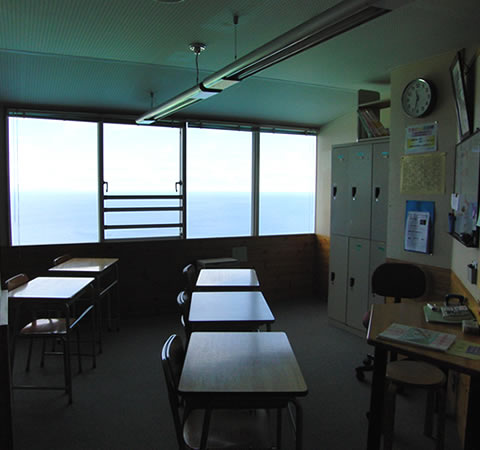Aogashima Island : A double volcano with distinctive natural surroundings and geography - Part 3

The highlight of Aogashima travel is not only viewing the double volcanic craters, but also hiking inside them. The inside of the large crater is beautifully covered with forest greens, including tropical plant bird’s-nest ferns, rarely seen in Japan. A little like a jungle with no trails, where adventurous hiking can be experienced. However, please remember that hikers must ask someone on the island for a guide. Once you enter the dense forest, you should watch your steps very carefully as the forest is a volcanic caldera formed with bumpy lava rocks, and you could lose your direction very quickly. In fact, even the island people get lost, although they remain calm and soon find their way back. Indeed, they seem always calm, as well as perseverant, cooperative and kind to everybody - that must be the nature of Aogashima people, acquired through living in this very distinct natural environment.

Aogashima is the smallest village in Japan, with a population of 170 people, decreasing little by little. The 25 students at the primary/junior high school, will be leaving the island at the age of fifteen to go to high school on the mainland. Nobody knows when they will be back to Aogashima. What the people sing here in their folklore songs are mostly about stories of leaving the island and parting with their loved ones.
To say good bye, they don’t say words meaning “See you again”, instead, they say Omouwayou, in their dialect, meaning “Thinking of you”.
Aogashima Island Information

Activities on Aogashima Island
Hiking, Star-Watching, Souna-bathing (at community sauna “Fureai Sauna”) , Shochu-Drinking, Camping, Walking and total relaxation :-) Or do nothing and just relax!Food
Cooked herbs (especially Ashitaba Herbs) and mountain vegetable are the specialties of the island. Fresh seafood is also available and other Japanese cuisines, like Sushi or Sashimi. Aochu, a brand of shochu liquor is worth a try. Hingya salt is a must.Weather
The average temperature is from 10 to 30C. The humidity, annually, is 85% on average. It is so humid in summer, but a cool wind blows from the sea that control the temperature. Caution is needed during spring storms and autumn typhoons. Strong winds blow from the west in the winter.Hot to get there
There is no direct transportation from the mainland Japan. A passenger boat and a helicopter service are available to access from Hachijojima Island.By Passenger Boat "Kanju Maru"
Kanju Maru sails once a day, Monday to Saturdays, taking between 2 1/2 to 4 hours from Hachijojima. Please note, the boat service is often cancelled due to bad sea conditions.
By Helicopter Service "Tokyo Island Shuttle Helicommuter Service"
20 minutes to Aogashima from Hachijojima, flights operated daily.
*Be sure to make a reservation prior to travel. It is essential, especially in summer as seats are booked so quickly.
Accommodations
Accommodations available in Aogashima are mostly Small Ryokan (Japanese Inns) or Minshuku (Pensions), rooms in the traditional Japanese style of accommodations. You can not expect very modern facilities, but they are comfortable, and they are neat and tidy. Amenities like toothbrush or towels might not be provided, so you need to bring your own. Since there is no restaurant in the island, rooms of pensions in Aogashima usually come with breakfast, lunch and dinner service. (It depends on the pension you stay. Make sure when booking.) There are 6 pensions and small Ryokans in Aogashma.It is strongly recommended to make a reservation for accommodation after you booked a ticket for boat/or air. If you let the staff at the accommodation know of your arrival time, they will pick you up at the port.
Information Center
There is no tourist information office on the island. Maps and brochures are available at the village admin office.Related Web Links
Tokyo Metropolitan Islands Promotion Corporation
Aogashima Village} (Japanese website)
Tokyo Island Shuttle Helicommuter (Toho Air Service Co.,Ltd.)
Aogashima - Part 1
Aogashima - Part 2
Aogashima - Part 3

